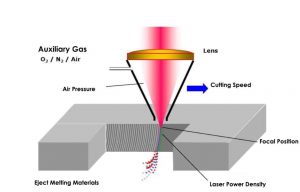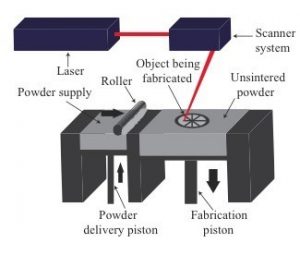- Technological development of lasers evolved rapidly and lower cost, highly reliable, fibers lasers were used to accurately engrave and mark parts.
- Use of laser across many industries has led to growth in use and processes.
- Lasers processing continues to get more powerful, accurate, and cost-effective.
Developed in 1965 by Western Electric, the very first production laser was utilized to drill holes in diamond dies. A couple of years later, a laser was used to successfully cut 1 millimeter-thick steel sheet and by 1975 a CO2 cutting system was commercially available. Laser welding was developed in the 1980s as a precise, clean, high-speed alternative to traditional methods of joining parts. The technologies evolved rapidly and soon lower cost, highly reliable, fiber lasers were being used to accurately engrave and mark parts. More recently, additive manufacturing utilizes laser energy to fuse powder-based materials into parts that are not manufacturable by any traditional means. The use of lasers across many industries is nothing short of amazing and the growth trend is expected to continue. Here are six common industrial processes that utilize lasers in today’s modern factories:
- Drilling – Laser drilling has emerged as a practical method for creating small holes, as tiny as 0.0005” in diameter. Especially challenging are applications with a large depth-to-diameter ratio. Laser drilling is the process of repeatedly pulsing focused laser energy at a material, vaporizing it layer by layer until a hole is created. Lasers are capable of drilling holes with exacting precision in metals, ceramics, plastic, and rubber.
- Cutting – A laser cutter works by focusing the output of a high-power laser on the material to be cut. The intense beam of coherent light can heat, melt, or vaporize the selected area and leaves a clean, burr-free edge with a high-quality surface finish. Lasers are typically used to process thinner materials; however, steel up to one inch thick can be processed on modern laser-based cutting systems. Most industrial cutting systems utilize a nozzle, with a pressurized gas assist, to help remove the molten material from the cutting zone.

- Welding – Laser welding equipment allows for precision welds and high welding rates. Generally, a filler material is not required, which makes it an ideal method of joining two dissimilar metals without any risk of contamination. The application of heat is well controlled and little, if any, joint preparation is required. Millisecond-long pulses effectively weld thin materials, while continuous laser systems are more suitable when deep welds are required.
- Marking – Now relatively common in today’s factories, a laser can be used to produce a permanent marking on almost any surface and material. The laser is used to modify the base substrate’s surface in such a way that light is reflected differently in the marked area, producing a human or sensor readable character. This process is appropriate for metals and plastics, is high resolution and is extremely fast compared to other methods.
- Heat Treatment and Annealing – This process, like marking, also modifies the surface of the part. The laser controllably adds energy to the targeted area, heating the base material to the temperature and depth specified by the process engineer.

- Additive Manufacturing – Selective laser melting (SLM) and Selective Laser Sintering (SLS) are relatively new processes utilizing laser energy. Additive manufacturing is advancing rapidly and could dramatically change the way parts are designed and manufactured in the future. A laser is focused on a bed of powdered material, melting or fusing the particles together. A 3D-printed part is formed layer by layer within the powder bed. When printing is complete, the unfused powder is removed and the part geometry is revealed. The SLS process requires an additional fusing step in a furnace since the powder is not completely melted by the laser.
Lasers for industrial material processing continue to get more powerful, accurate, and cost-effective to meet the challenges of global manufacturing companies. Keller Technology Corporation can help you integrate any of these laser processes into your automated assembly system. Contact Keller Technology to learn more about possible solutions to your most challenging manufacturing problems.

